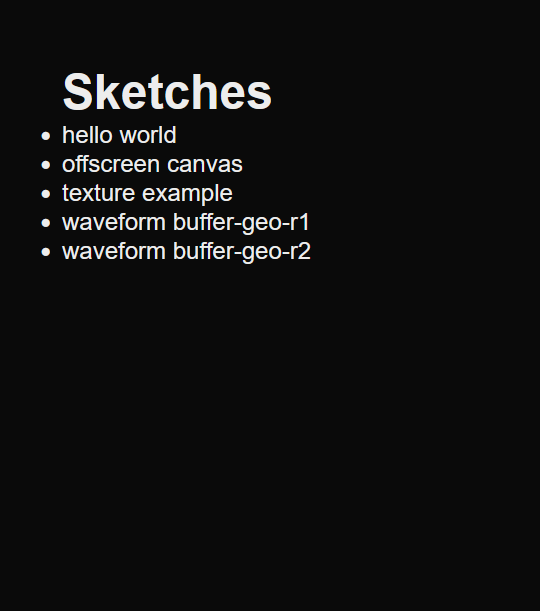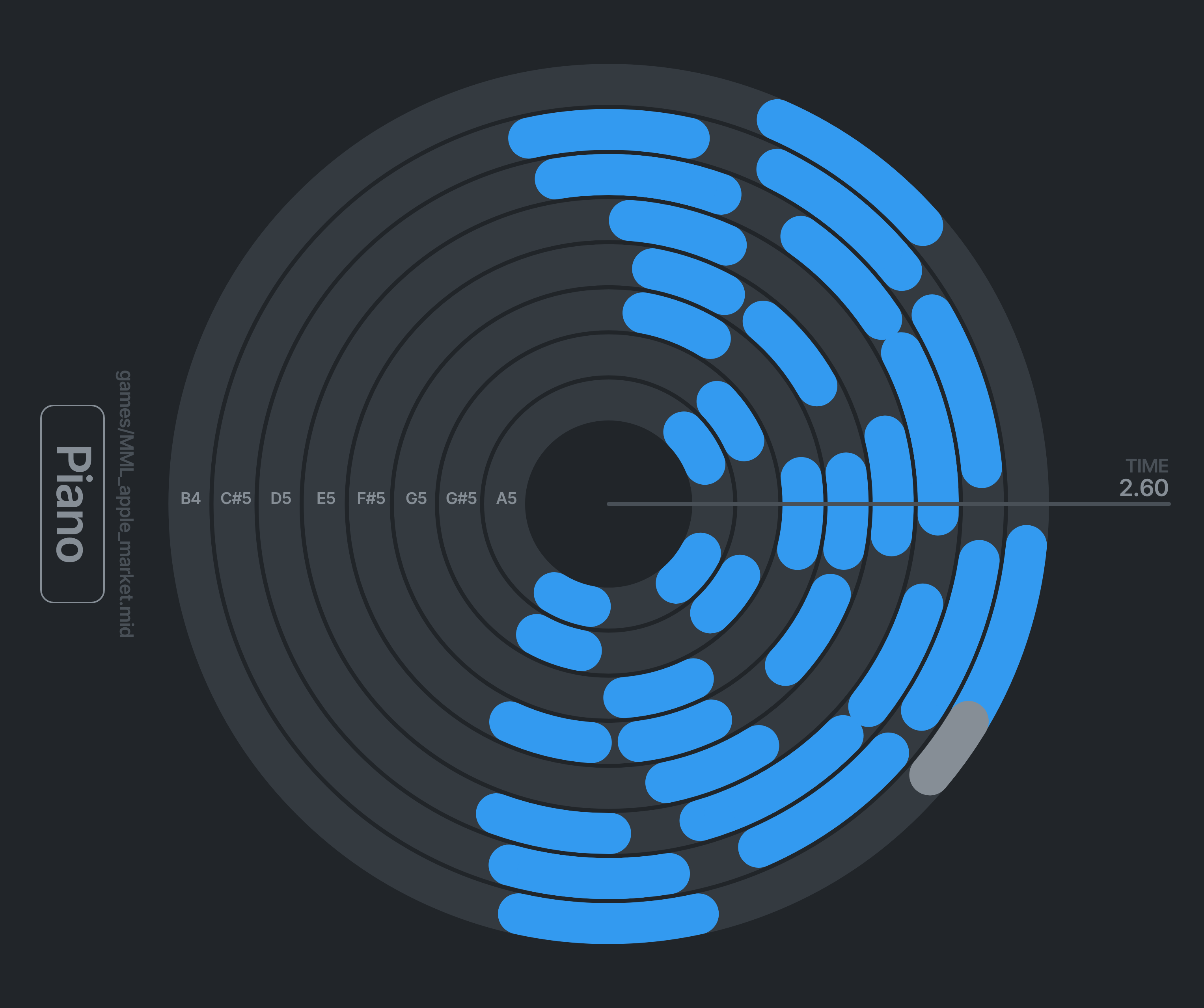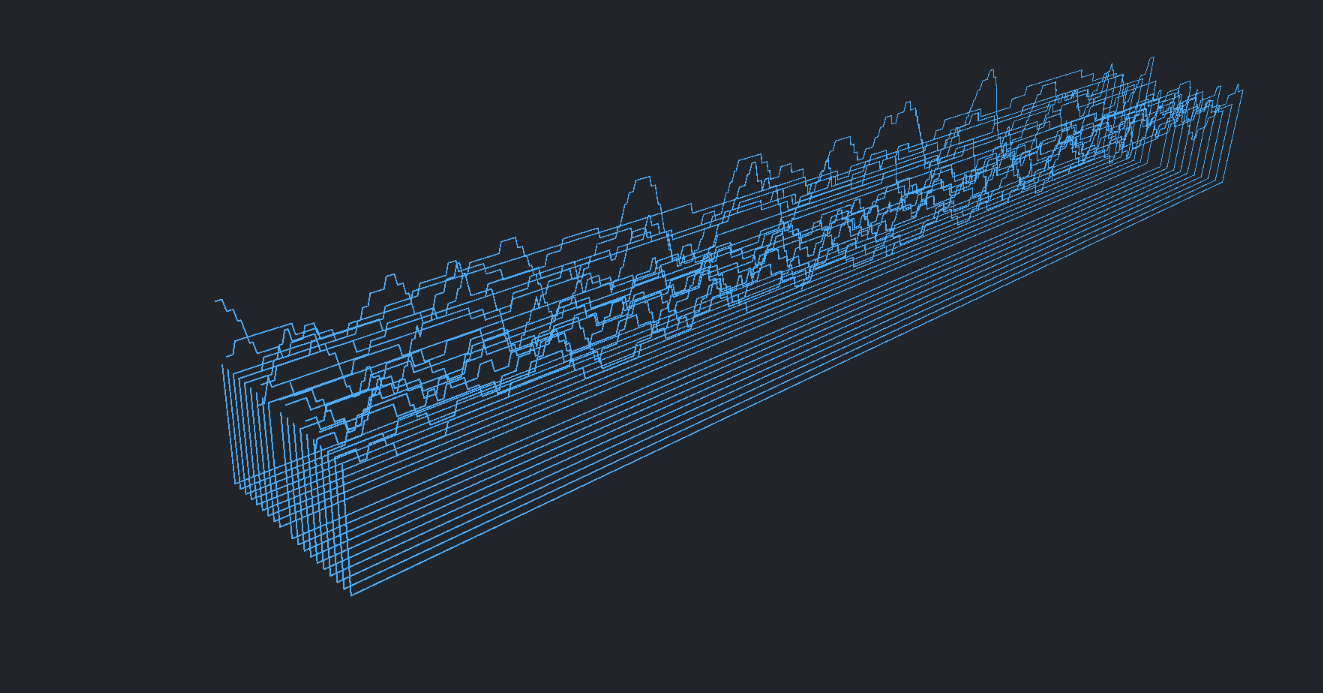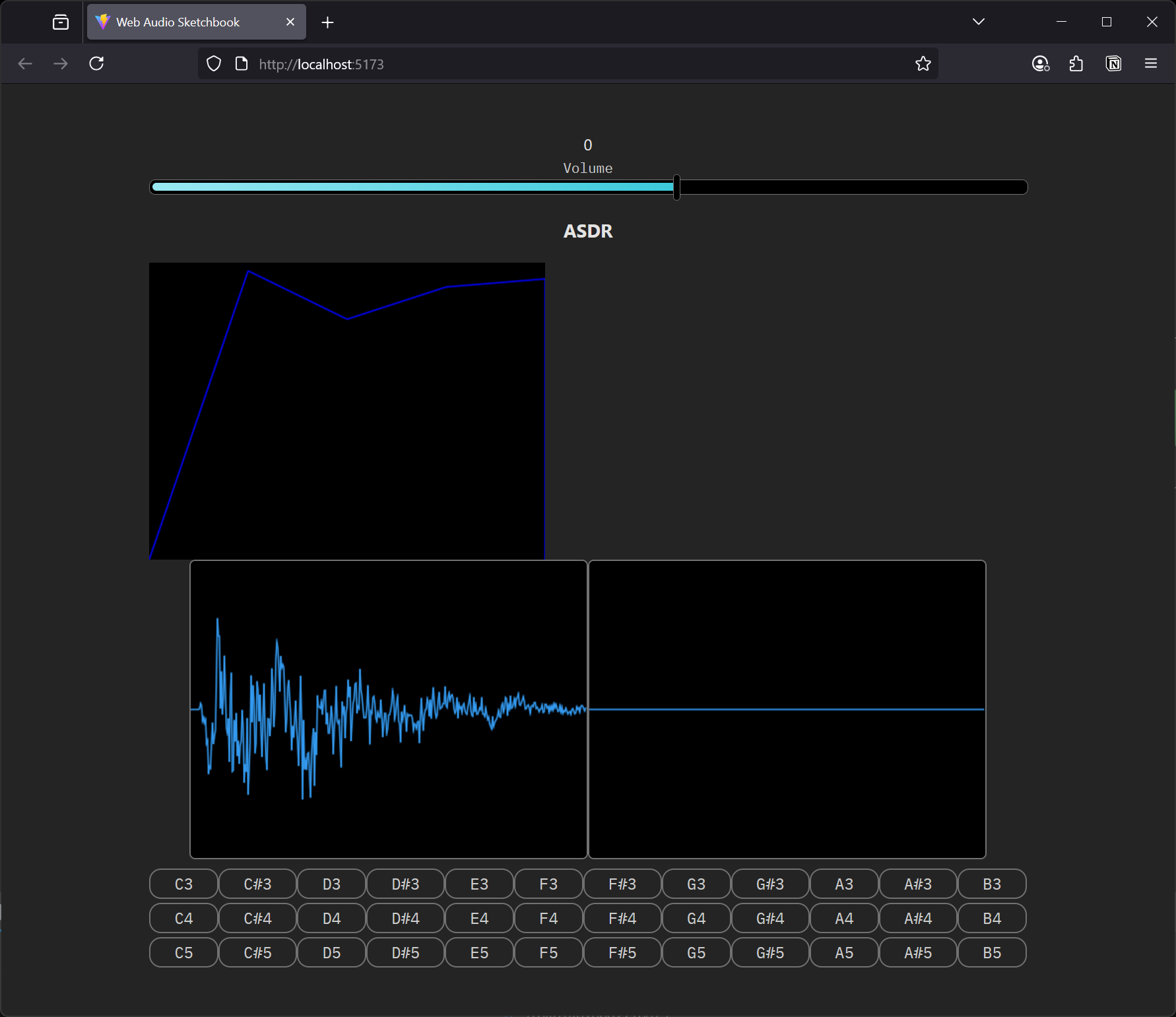Recently I’ve been stacking up quite a few digital sketchbooks with experiments ranging from 3D to web audio to animations. Anything I’ve been interested in tinkering with, with my “sketchbooks” I have a place I can quickly come and iterate on ideas without boundaries.
I thought I’d briefly share my process creating the sketchbooks, how they work, and share a few cool examples of “sketches”.
Stacks of sketchbooks
I’ve got a “sketchbook” for each topic I’m interested in exploring.
- 2D graphics using p5.js
- Web Audio
- 3D using ThreeJS / R3F
- Web (using ReactJS)
- React Native (Expo)
Whenever I have an idea in one of these topics, I open up one of these projects and get started on it.
My process
I’ve tried to make the process as streamlined as possible so I can get in and start working on ideas instead of spinning wheels doing file or project management.
So here’s my process for starting a new sketch in my “sketchbook”:
- Get an idea
- Open up the corresponding sketchbook project in VSCode
- Run
yarn sketch:new CoolNewExperimentR1 - Start noodling in
/src/sketch/CoolNewExperimentR1.tsx - Preview my sketch on web at
localhost:4200/sketches/my-cool-experiment-r1 - Create another “round” of sketching
yarn sketch:new CoolNewExperimentR2 - Copy over any relevant code.
- Rinse repeat
This flow has been working pretty well for me. I usually challenge myself to work for 20-30 mins max at a time in short sprints, so the ability to pick up one of these “sketchbooks” and start “doodling” with code is essential.
To make it a bit faster, I created an app launcher called Entourage. I added all my sketchbooks so I can quickly click one and open VSCode with the project ready.
 The Entourage app with 5 cards in a row representing different sketchbooks.
The Entourage app with 5 cards in a row representing different sketchbooks.
Sketchbook Structure
With the p5.js sketchbook I made a nice little architecture for myself to simplify starting up new ideas. Then afterwards, each sketchbook I created was forked from that project.
yarn sketch:new
I used to open up one of the sketchbook projects, create a new branch, and go from there. And all my experiments were sorted into git branches. This works great, but I wanted to be able to see all my experiments at once and share code between them if needed.
Now, I open up the sketchbook and I run yarn sketch:new MyIdeaName and it scaffolds a new “sketchbook page” for me to work on. It uses a simple NodeJS CLI script I wrote.
It literally generates a new page in the router, so I can go to localhost:4200/sketches/my-idea-name and see my sketch.
It also copies a template for a “hello world” React component for whatever sketchbook I’m using. In the p5.js project, it generates a SketchComponent that has an instance of p5 spun up with sample code.
The CLI script also accepts a template parameter, so I can use a different template for my new sketch. In the p5 project for example, I have a template for offscreen rendering that has all the logic for spinning up an offscreen canvas. All the templates are stored in a top level /templates folder.
The script itself isn’t too wild — it does exactly what we need: copies a few templates, replaces a few placeholders, and creates new files on disk.
const { readFileSync, copyFileSync, writeFileSync, existsSync } = require("fs");
const path = require("path");
const TEMPLATES = {
sketch: "SketchTemplate",
offscreen: "OffscreenTemplate",
"render-video": "RenderImageSequenceTemplate",
};
function convertToSlug(componentName) {
return (
componentName
.replace(/([a-z])([A-Z])/g, "$1-$2") // Convert camelCase to kebab-case
// .replace(/[^a-z0-9-]+/g, "-") // Remove special characters
.toLowerCase()
);
}
function findAndReplaceInFile(sourceFilePath, replaceSearch, replaceTerm) {
var data = readFileSync(sourceFilePath, "utf-8");
var newValue = data.replaceAll(replaceSearch, replaceTerm);
writeFileSync(sourceFilePath, newValue, "utf-8");
}
const generateSketch = async () => {
if (process.argv.length < 3)
throw new Error(
"Please provide a name for a new React component for sketching (e.g. 'SketchExample')"
);
const sketchName = process.argv[2];
let template = process.argv[3];
if (!template) template = "sketch";
console.log(`⚙️ Creating a new sketch called <${sketchName} />`);
// Get template for component and copy it
const templateFilename = TEMPLATES[template];
const componentTemplatePath = path.join(
__dirname,
"../templates",
`${templateFilename}.tsx`
);
const componentDestinationPath = path.join(
__dirname,
"../src/experiments/",
`${sketchName}.tsx`
);
const componentFileExists = existsSync(componentDestinationPath);
if (componentFileExists) {
console.error(
"Component already exists! Try picking another name or deleting the old file."
);
return;
}
copyFileSync(componentTemplatePath, componentDestinationPath);
// Swap out placeholder name
findAndReplaceInFile(
componentDestinationPath,
"ExampleComponent",
sketchName
);
// Get template for page and copy it
const pageTemplatePath = path.join(__dirname, "../templates", "page.tsx");
const pageName = convertToSlug(sketchName);
const pageDestinationPath = path.join(
__dirname,
"../src/pages/experiments/",
`${pageName}.tsx`
);
copyFileSync(pageTemplatePath, pageDestinationPath);
// Swap out placeholder name
findAndReplaceInFile(pageDestinationPath, "ExampleComponent", sketchName);
// Done!
console.log("Done! 🤘");
console.log(`Created new sketch component: ${componentDestinationPath}`);
console.log(`Created new sketch page: ${pageDestinationPath}`);
const url = `http://localhost:3000/experiments/${pageName}`;
console.log(`Live preview: ${url}`);
};
generateSketch();
This is nice and extensible for each project. I just provide a solid default template for a “sketch”, a page component (usually just NextJS filler code), and I’m good to go.
I’m able to run this using yarn sketch:new by adding the .js script to the scripts section of my package.json:
"scripts": {
"sketch:new": "node scripts/generate-sketch.js"
},
Index Page
One of the key things I wanted with the sketchbook was the ability to browse any sketch I’d like - without having to switch git branches.
Using NextJS and their getStaticProps API, I was able to fetch all the sketch pages using the NodeJS filesystem API. Since I generate a static page for each route inside a /pages/sketches/ folder, I just have to check for all files inside there.
import { readdirSync } from "fs";
import path from "path";
export async function getStaticProps() {
const experimentPath = path.join("./src/pages/sketches");
const experimentPages = readdirSync(experimentPath);
const pages = experimentPages.map((page) => page.replace(".tsx", ""));
return {
props: {
title: "",
pages,
},
};
}
And since the filenames match the URL slug, it doesn’t take much work to link to them.
import { Head } from "next/document";
import Link from "next/link";
import path from "path";
type Props = {
pages: string[];
};
export default function Page({ pages }: Props) {
return (
<>
<div style={{ padding: "3rem" }}>
<h1>Sketches</h1>
<ul>
{pages.map((page) => (
<li key={page}>
<Link href={`/sketches/${page}`}>{page.replace("-", " ")}</Link>
</li>
))}
</ul>
</div>
</>
);
}
And it doesn’t look too fancy (yet), but it gets the job done.
 A black web page with a simple list of links to prototypes
A black web page with a simple list of links to prototypes
Page wrappers
Since I was displaying all the sketches in one place, I wanted the be able to control the uniformity of their layout from a single place.
With each sketchbook I tend to create a “page wrapper” type component that wraps each sketch. It could be used to apply a nice frame around the page with the sketch information — or just apply the sketch name to the <title> in the meta tags.
Here’s the wrapper I use for the 3D sketchbook, it just displays the name of the current sketch in the page title.
import Head from "next/head";
import { PropsWithChildren } from "react";
type Props = {
title: string;
};
export default function SketchPage({
title,
children,
}: PropsWithChildren<Props>) {
return (
<>
<Head>
<title>{title && `${title} - `}Ryo's 3D Web Sketchbook</title>
</Head>
<div style={{ position: "fixed", inset: 0 }}>{children}</div>
</>
);
}
The top sketches
Here are a few standout sketches I’ve put together this year.
Circular MIDI Tracks
 A MIDI track visualized as multiple circular tracks for each note with rounded blocks traveling along each
A MIDI track visualized as multiple circular tracks for each note with rounded blocks traveling along each
This one was pretty fun, it’s from the p5.js sketchbook. It takes a MIDI file, generates a circle “track” for each note that gets played, and animates line segments representing each note around the circle track. It
You can check out the source code here.
Audio Waveform “Slices”
 Rectangles stacked side by side with the top line shapes like a waveform
Rectangles stacked side by side with the top line shapes like a waveform
This is from the p5.js sketchbook. I play pre-recorded audio of me playing piano I created using Ableton Live and Arturia synths. Then I sample the waveform data at regular intervals to create “slices of audio waves. It’s a bit slow, but it could be optimized in a few clever ways (if I had more time).
You can check out the source code here.
ADSR Envelope with Visualizer
 A web app with an ADSR curve and waveform visualized on canvas, and buttons below with piano note keys
A web app with an ADSR curve and waveform visualized on canvas, and buttons below with piano note keys
Recently in the web audio sketchbook I got a ADSR (attack, delay, sustain, release) envelope setup on a sampler (e.g. plays 1 sound at different “pitches” aka piano keys).
And to better understand the effect of the envelope on the audio output, I created a visualization of the ADSR properties mapped on a line graph.
You can check out the source code here.
Frequency Tunnel Viz
 A web app with a black background and blue particles floating in space gathered in a sphere shape and exploding outwards based on keypress
A web app with a black background and blue particles floating in space gathered in a sphere shape and exploding outwards based on keypress
There’s definitely a trend of audio visualization here. This is in the 3D sketchbook. It takes audio waveform data and animates hundreds of particles based on the frequency - with a bit of extra math to make things look interesting.
You can check out the source code here.
What’s left?
There’s 2 key areas missing from the template that would make it perfect for me.
The first, it needs another script for copying sketches. It should be able to take a sketch name and copy it to a new file (similar to the new process but using another sketch as the “template”). Currently when I do iterations I tend to just create a new sketch and copy over anything I need.
The second, it needs a way to share code between other sketchbooks of similar types. When I need to do some audio work in my 3D sketchbook, it should be a simple import from a shared library that the audio sketchbook also uses.
This ones a little trickier to solve just practically. Technically it’s simple - I have to bite the bullet and just convert my sketchbook to a monorepo, add a shared library as a git submodule, and go from there. But practically — does it just include all my utilities? Do I make submodules for each topic - and just import each sketchbook as a submodule? We’ll find out.
Get sketching!
Feel free to use my sketchbooks as the basis for your own. They’re all licensed with the “UNLICENSE” usually. Same with the “sketches” really. So go wild.
If you make anything cool make sure to tag me on socials so I can see it and share it with my circles.
Stay creative, Ryo








